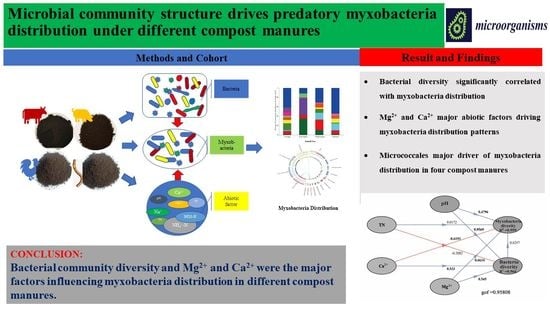Community Profile and Drivers of Predatory Myxobacteria under Different Compost Manures
Abstract
:1. Introduction
2. Materials and Methods
2.1. Sample Collection and Analysis
2.2. DNA Extraction, 16S rRNA Gene Amplification, and MiSeq PE300 Sequencing
2.3. Data Analysis
2.4. Predatory Myxobacteria Community Abundance
2.5. Statistical Analysis
3. Results
3.1. Bacteria and Myxobacteria Diversity and Abundance in Different Compost Manures
3.2. Myxobacteria Community Structure among the Four Compost Manures
3.3. Correlations between Myxobacteria and Bacterial Community Diversity
3.4. Correlation between Myxobacteria Community Diversity and Composition, and Environmental Parameters
3.5. Network Analysis and Structural Equation Modeling of Myxobacteria Community Structure in Compost Manures
4. Discussion
4.1. Myxobacteria Community Structure in Different Compost Manures
4.2. Effects of Abiotic Factors on Myxobacteria Community Structure in Compost Manure
4.3. Effect of Manure Compost Bacterial Diversity on Myxobacteria Community Structure
5. Conclusions
Supplementary Materials
Author Contributions
Funding
Institutional Review Board Statement
Informed Consent Statement
Data Availability Statement
Acknowledgments
Conflicts of Interest
References
- Schmitz, O.J. Predator diversity and trophic interactions. Ecology 2007, 88, 2415–2426. [Google Scholar] [CrossRef]
- Perez, J.; Moraleda-Munoz, A.; Marcos-Torres, F.J.; Munoz-Dorado, J. Bacterial predation: 75 years and counting! Environ. Microbiol. 2016, 18, 766–779. [Google Scholar] [CrossRef] [PubMed]
- Pasternak, Z.; Pietrokovski, S.; Rotem, O.; Gophna, U.; Lurie-Weinberger, M.N.; Jurkevitch, E. By their genes ye shall know them: Genomic signatures of predatory bacteria. ISME J. 2013, 7, 756–769. [Google Scholar] [CrossRef] [Green Version]
- José, M.-D.; Marcos-Torres, F.J.; Elena, G.-B.; Aurelio, M.-M.; Juana, P. Myxobacteria: Moving, Killing, Feeding, and Surviving Together. Front. Microbiol. 2016, 7, 781. [Google Scholar]
- Lu, Z.; Tillmann, L. Micropredator niche differentiation between bulk soil and rhizosphere of an agricultural soil depends on bacterial prey. FEMS Microbiol. Ecol. 2017, 93, 9. [Google Scholar]
- Zhou, Y.; Zhang, X.; Yao, Q.; Zhu, H. Both Soil Bacteria and Soil Chemical Property Affected the Micropredator Myxobacterial Community: Evidence from Natural Forest Soil and Greenhouse Rhizosphere Soil. Microorganisms 2020, 8, 1387. [Google Scholar] [CrossRef]
- Kou, W.; Zhang, J.; Lu, X.; Ma, Y.; Mou, X.; Wu, L. Identification of bacterial communities in sediments of Poyang Lake, the largest freshwater lake in China. Springerplus 2016, 5, 401. [Google Scholar] [CrossRef] [Green Version]
- Mohr, K.I.; Stechling, M.; Wink, J.; Wilharm, E.; Stadler, M. Comparison of myxobacterial diversity and evaluation of isolation success in two niches: Kiritimati Island and German compost. Microbiologyopen 2016, 5, 268–278. [Google Scholar] [CrossRef]
- Powell, J.T.; Chatziefthimiou, A.D.; Banack, S.A.; Cox, P.A.; Metcalf, J.S. Desert crust microorganisms, their environment, and human health. J. Arid. Environ. 2015, 112, 127–133. [Google Scholar] [CrossRef]
- Singh, B.N. Myxobacteria in soils and composts; their distribution, number and lytic action on bacteria. J. Gen. Microbiol. 1947, 1, 1–10. [Google Scholar] [CrossRef] [Green Version]
- Lueders, T.; Kindler, R.; Miltner, A.; Friedrich, M.W.; Kaestner, M. Identification of bacterial micropredators distinctively active in a soil microbial food web. Appl. Environ. Microbiol. 2006, 72, 5342–5348. [Google Scholar] [CrossRef] [PubMed] [Green Version]
- Ye, X.; Li, Z.; Luo, X.; Wang, W.; Li, Y.; Li, R.; Zhang, B.; Qiao, Y.; Zhou, J.; Fan, J.; et al. A predatory myxobacterium controls cucumber Fusarium wilt by regulating the soil microbial community. Microbiome 2020, 8, 49. [Google Scholar] [CrossRef] [PubMed] [Green Version]
- Dai, W.; Jiu, M.; Wang, W.; Cui, Z.; Wang, H. Effects of myxobacteria predation on microbial community structure of artificial microcosm. Acta Microbiol. Sin. 2020, 60, 452–463. [Google Scholar]
- Sutton, D.; Livingstone, P.G.; Furness, E.; Swain, M.T.; Whitworth, D.E. Genome-Wide Identification of Myxobacterial Predation Genes and Demonstration of Formaldehyde Secretion as a Potentially Predation-Resistant Trait of Pseudomonas aeruginosa. Front. Microbiol. 2019, 10. [Google Scholar] [CrossRef]
- Liu, S.; Wang, J.; Pu, S.; Blagodatskaya, E.; Kuzyakov, Y.; Razavi, B.S. Impact of manure on soil biochemical properties: A global synthesis. Sci. Total Environ. 2020, 745, 141003. [Google Scholar] [CrossRef]
- Luo, G.; Li, L.; Friman, V.-P.; Guo, J.; Guo, S.; Shen, Q.; Ling, N. Organic amendments increase crop yields by improving microbe-mediated soil functioning of agroecosystems: A meta-analysis. Soil Biol. Biochem. 2018, 124, 105–115. [Google Scholar] [CrossRef]
- Sanford, R.A.; Cole, J.R.; Tiedje, J.M. Characterization and description of Anaeromyxobacter dehalogenans gen. nov., sp. nov., an aryl-halorespiring facultative anaerobic myxobacterium. Appl. Environ. Microbiol. 2002, 68, 893–900. [Google Scholar] [CrossRef] [Green Version]
- Tanahashi, T.; Murase, J.; Matsuya, K.; Hayashi, M.; Kimura, M.; Asakawa, S. Bacterial Communities Responsible for the Decomposition of Rice Straw Compost in a Japanese Rice Paddy Field Estimated by DGGE Analysis of Amplified 16S rDNA and 16S rRNA Fragments. Soil Sci. Plant Nutr. 2005, 51, 351–360. [Google Scholar] [CrossRef]
- Wang, W.; Wang, H.; Feng, Y.; Wang, L.; Xiao, X.; Xi, Y.; Luo, X.; Sun, R.; Ye, X.; Huang, Y.; et al. Consistent responses of the microbial community structure to organic farming along the middle and lower reaches of the Yangtze River. Sci. Rep. 2016, 6, 35046. [Google Scholar] [CrossRef] [Green Version]
- Wang, W.; Luo, X.; Ye, X.; Chen, Y.; Wang, H.; Wang, L.; Wang, Y.; Yang, Y.; Li, Z.; Cao, H.; et al. Predatory Myxococcales are widely distributed in and closely correlated with the bacterial community structure of agricultural land. Appl. Soil Ecol. 2020, 146, 103365. [Google Scholar] [CrossRef]
- Zhou, X.-W.; Li, S.-G.; Li, W.; Jiang, D.-M.; Han, K.; Wu, Z.-H.; Li, Y.-Z. Myxobacterial community is a predominant and highly diverse bacterial group in soil niches. Environ. Microbiol. Rep. 2014, 6, 45–56. [Google Scholar] [CrossRef] [PubMed]
- Bolger, A.M.; Marc, L.; Bjoern, U. Trimmomatic: A flexible trimmer for Illumina sequence data. Bioinformatics 2014, 30, 2114–2120. [Google Scholar] [CrossRef] [PubMed] [Green Version]
- Masella, A.P.; Bartram, A.K.; Truszkowski, J.M.; Brown, D.G.; Neufeld, J.D. PANDAseq: Paired-end assembler for illumina sequences. BMC Bioinform. 2012, 13, 1–7. [Google Scholar] [CrossRef] [PubMed] [Green Version]
- Mago, T.; Salzberg, S.L. FLASH: Fast length adjustment of short reads to improve genome assemblies. Bioinformatics 2011, 27, 2957–2963. [Google Scholar] [CrossRef] [PubMed]
- Schloss, P.D.; Westcott, S.L.; Ryabin, T.; Hall, J.R.; Hartmann, M.; Hollister, E.B.; Lesniewski, R.A.; Oakley, B.B.; Parks, D.H.; Robinson, C.J.; et al. Introducing mothur: Open-source, platform-independent, community-supported software for describing and comparing microbial communities. Appl. Environ. Microbiol. 2009, 75, 7537–7541. [Google Scholar] [CrossRef] [PubMed] [Green Version]
- Schloss, P.D.; Dirk, G.; Westcott, S.L. Reducing the effects of PCR amplification and sequencing artifacts on 16S rRNA-based studies. PLoS ONE 2011, 6, e27310. [Google Scholar] [CrossRef] [Green Version]
- Robinson, M.D.; McCarthy, D.J.; Smyth, G.K. edgeR: A Bioconductor package for differential expression analysis of digital gene expression data. Bioinformatics 2010, 26, 139–140. [Google Scholar] [CrossRef] [Green Version]
- Jorgensen, T.D.; Jak, S. Review of Gana & Broc’s Structural Equation Modeling with lavaan. Psychometrika 2020, 85, 373–377. [Google Scholar] [CrossRef]
- Segata, N.; Izard, J.; Waldron, L.; Gevers, D.; Miropolsky, L.; Garrett, W.S.; Huttenhower, C. Metagenomic biomarker discovery and explanation. Genome Biol. 2011, 12. [Google Scholar] [CrossRef] [Green Version]
- Griffiths, R.I.; Thomson, B.C.; James, P.; Bell, T.; Bailey, M.; Whiteley, A.S. The bacterial biogeography of British soils. Environ. Microbiol. 2011, 13, 1642–1654. [Google Scholar] [CrossRef]
- Cai, L.; Gong, X.; Sun, X.; Li, S.; Yu, X. Comparison of chemical and microbiological changes during the aerobic composting and vermicomposting of green waste. PLoS ONE 2018, 13, e0207494. [Google Scholar] [CrossRef] [PubMed] [Green Version]
- Garcia, R.; Müller, R. The Family Nannocystaceae; Springer: Berlin/Heidelberg, Germany, 2014; pp. 213–229. [Google Scholar]
- Probandt, D.; Knittel, K.; Tegetmeyer, H.E.; Ahmerkamp, S.; Holtappels, M.; Amann, R. Permeability shapes bacterial communities in sublittoral surface sediments. Environ. Microbiol. 2017, 19, 1584–1599. [Google Scholar] [CrossRef]
- Chen, M.; Xu, Y. Influence of the Assorted Usage of Wormcast and Pig Manure Compost on the Composition Change of Humus and Yield. Acta Agric. Boreali-Sin. 2014, 29, 233–238. [Google Scholar]
- Lv, B.; Xing, M.; Yang, J.; Zhang, L. Pyrosequencing reveals bacterial community differences in composting and vermicomposting on the stabilization of mixed sewage sludge and cattle dung. Appl. Microbiol. Biotechnol. 2015, 99, 10703–10712. [Google Scholar] [CrossRef]
- Wang, X.; Cui, H.; Shi, J.; Zhao, X.; Zhao, Y.; Wei, Z. Relationship between bacterial diversity and environmental parameters during composting of different raw materials. Bioresour. Technol. 2015, 198, 395–402. [Google Scholar] [CrossRef]
- Davison, J.; Moora, M.; Semchenko, M.; Adenan, S.B.; Ahmed, T.; Akhmetzhanova, A.A.; Alatalo, J.M.; Al-Quraishy, S.; Andriyanova, E.; Anslan, S.; et al. Temperature and pH define the realised niche space of arbuscular mycorrhizal fungi. New Phytol. 2021, 23, 763–776. [Google Scholar] [CrossRef] [PubMed]
- Jiang, C.; Peces, M.; Andersen, M.H.; Kucheryavskiy, S.; Nierychlo, M.; Yashiro, E.; Andersen, K.S.; Kirkegaard, R.H.; Hao, L.; Hogh, J.; et al. Characterizing the growing microorganisms at species level in 46 anaerobic digesters at Danish wastewater treatment plants: A six-year survey on microbial community structure and key drivers. Water Res. 2021, 193, 116871. [Google Scholar] [CrossRef] [PubMed]
- de Lima, N.M.M.; Munoz-Rojas, M.; Vazquez-Campos, X.; Zanini Branco, L.H. Biocrust cyanobacterial composition, diversity, and environmental drivers in two contrasting climatic regions in Brazil. Geoderma 2021, 386. [Google Scholar] [CrossRef]
- Pollierer, M.M.; Scheu, S. Driving factors and temporal fluctuation of Collembola communities and reproductive mode across forest types and regions. Ecol. Evol. 2017, 7, 4390–4403. [Google Scholar] [CrossRef]
- Mohr, K.I. Diversity of Myxobacteria-We Only See the Tip of the Iceberg. Microorganisms 2018, 6, 84. [Google Scholar] [CrossRef] [Green Version]
- Reichenbach, H. The ecology of the myxobacteria. Environ. Microbiol. 1999, 1, 15–21. [Google Scholar] [CrossRef]
- Geisseler, D.; Horwath, W.R.; Joergensen, R.G.; Ludwig, B. Pathways of nitrogen utilization by soil microorganisms—A review. Soil Biol. Biochem. 2010, 42, 2058–2067. [Google Scholar] [CrossRef]
- Chang, B.Y.; Dworkin, M. Isolated fibrils rescue cohesion and development in the Dsp mutant of Myxococcus xanthus. J. Bacteriol. 1994, 176, 7190–7196. [Google Scholar] [CrossRef] [PubMed] [Green Version]
- Kim, S.H.; Ramaswamy, S.; Downard, J. Regulated exopolysaccharide production in Myxococcus xanthus. J. Bacteriol. 1999, 181, 1496–1507. [Google Scholar] [CrossRef] [Green Version]
- Treuner-Lange, A.; Ward, M.J.; Zusman, D.R. Pph1 from Myxococcus xanthus is a protein phosphatase involved in vegetative growth and development. Mol. Microbiol. 2001, 40, 126–140. [Google Scholar] [CrossRef] [PubMed]
- Wang, J.; Hu, W.; Lux, R.; He, X.; Li, Y.; Shi, W. Natural Transformation of Myxococcus xanthus. J. Bacteriol. 2011, 193, 2122–2132. [Google Scholar] [CrossRef] [PubMed] [Green Version]
- Qiu, Z.; Li, Y.; Zhang, Y.; Gong, G.; Zhang, Y.; Wang, B. Influences of Seawater Ions on the Growth, Differerentiation of a Sait-Tolerant Myxobacterium Myxococcus fulvus HW-1. J. Mirobiology 2003, 23, 8–11. [Google Scholar]
- Regentin, R.; Frykman, S.; Lau, J.; Tsuruta, H.; Licari, P. Nutrient regulation of epothilone biosynthesis in heterologous and native production strains. Appl. Microbiol. Biotechnol. 2003, 61, 451–455. [Google Scholar] [CrossRef]
- Zengler, K.; Zaramela, L.S. The social network of microorganisms—How auxotrophies shape complex communities. Nat. Rev. Microbiol. 2018, 16, 383–390. [Google Scholar] [CrossRef]
- Wrótniak-Drzewiecka, W.; Brzezińska, A.J.; Dahm, H.; Ingle, A.P.; Rai, M. Current trends in myxobacteria research. Ann. Microbiol. 2015, 66, 17–33. [Google Scholar] [CrossRef]
- Crutsinger, G.M.; Collins, M.D.; Fordyce, J.A.; Gompert, Z.; Nice, C.C.; Sanders, N.J. Plant genotypic diversity predicts community structure and governs an ecosystem process. Science 2006, 313, 966–968. [Google Scholar] [CrossRef] [PubMed] [Green Version]
- Scherber, C.; Eisenhauer, N.; Weisser, W.W.; Schmid, B.; Voigt, W.; Fischer, M.; Schulze, E.D.; Roscher, C.; Weigelt, A.; Allan, E.; et al. Bottom-up effects of plant diversity on multitrophic interactions in a biodiversity experiment. Nature 2010, 468, 553–556. [Google Scholar] [CrossRef] [PubMed]
- Yang, J.W.; Wu, W.; Chung, C.C.; Chiang, K.P.; Gong, G.C.; Hsieh, C.H. Predator and prey biodiversity relationship and its consequences on marine ecosystem functioning-interplay between nanoflagellates and bacterioplankton. ISME J. 2018, 12, 1532–1542. [Google Scholar] [CrossRef] [PubMed] [Green Version]
- Morgan, A.D.; MacLean, R.C.; Hillesland, K.L.; Velicer, G.J. Comparative Analysis of Myxococcus Predation on Soil Bacteria. Appl. Environ. Microbiol. 2010, 76, 6920–6927. [Google Scholar] [CrossRef] [Green Version]
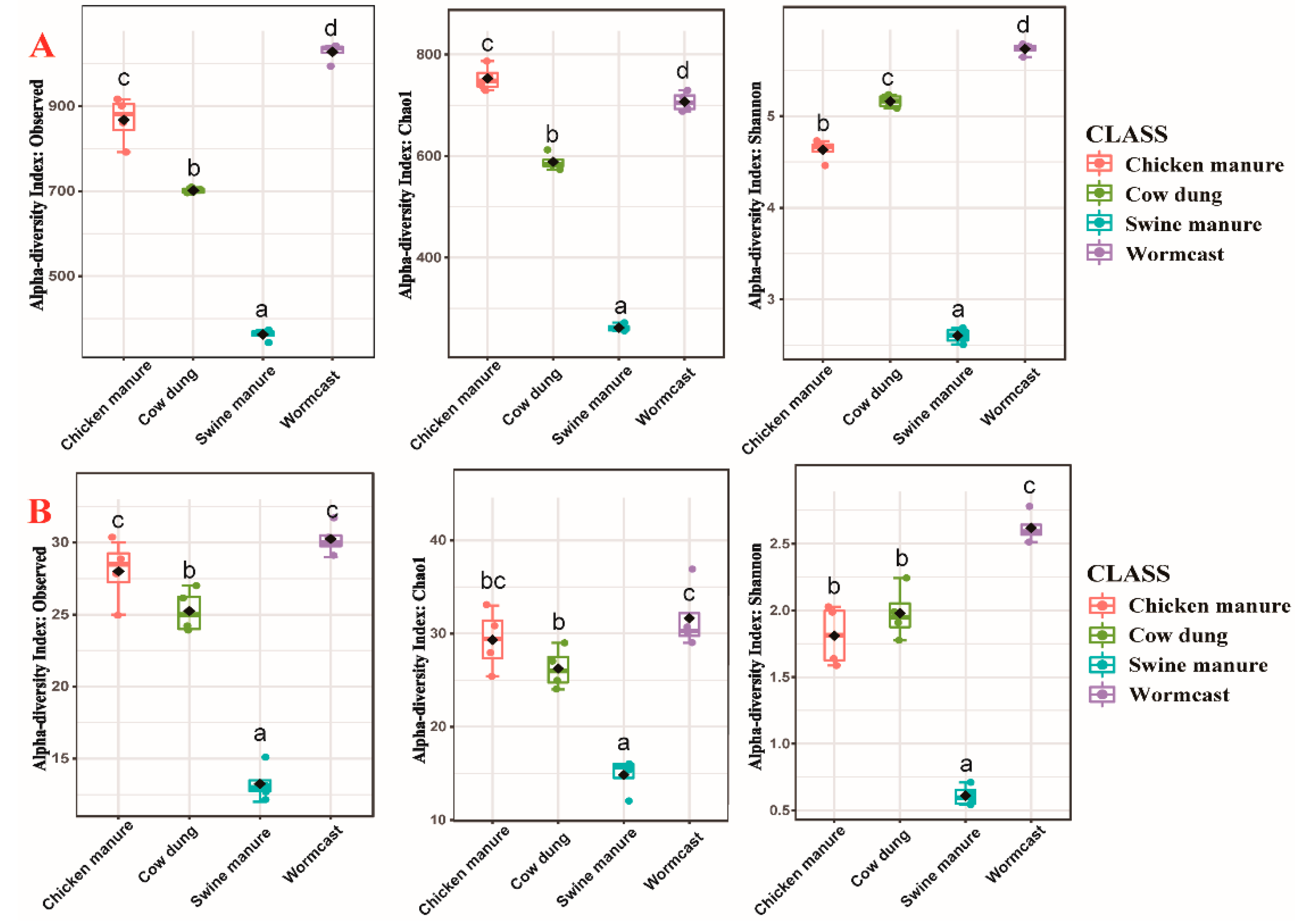
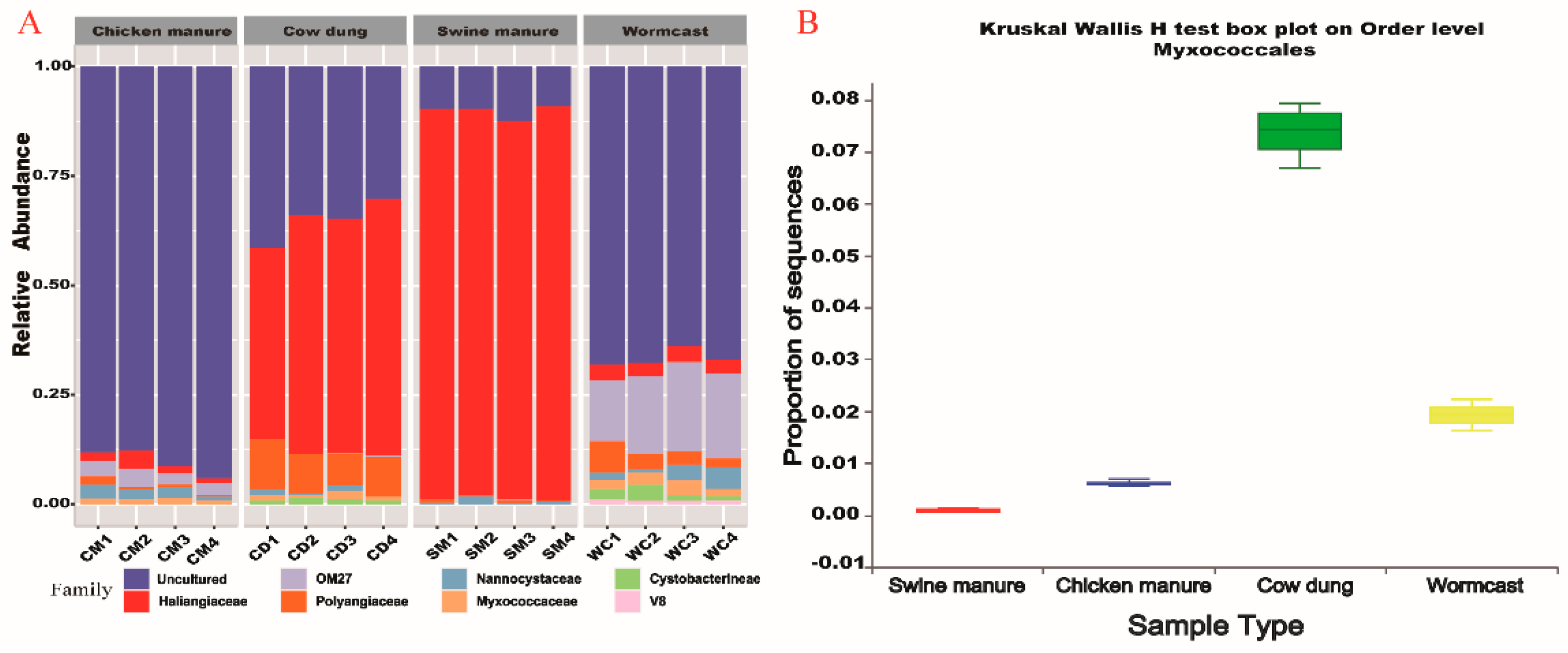
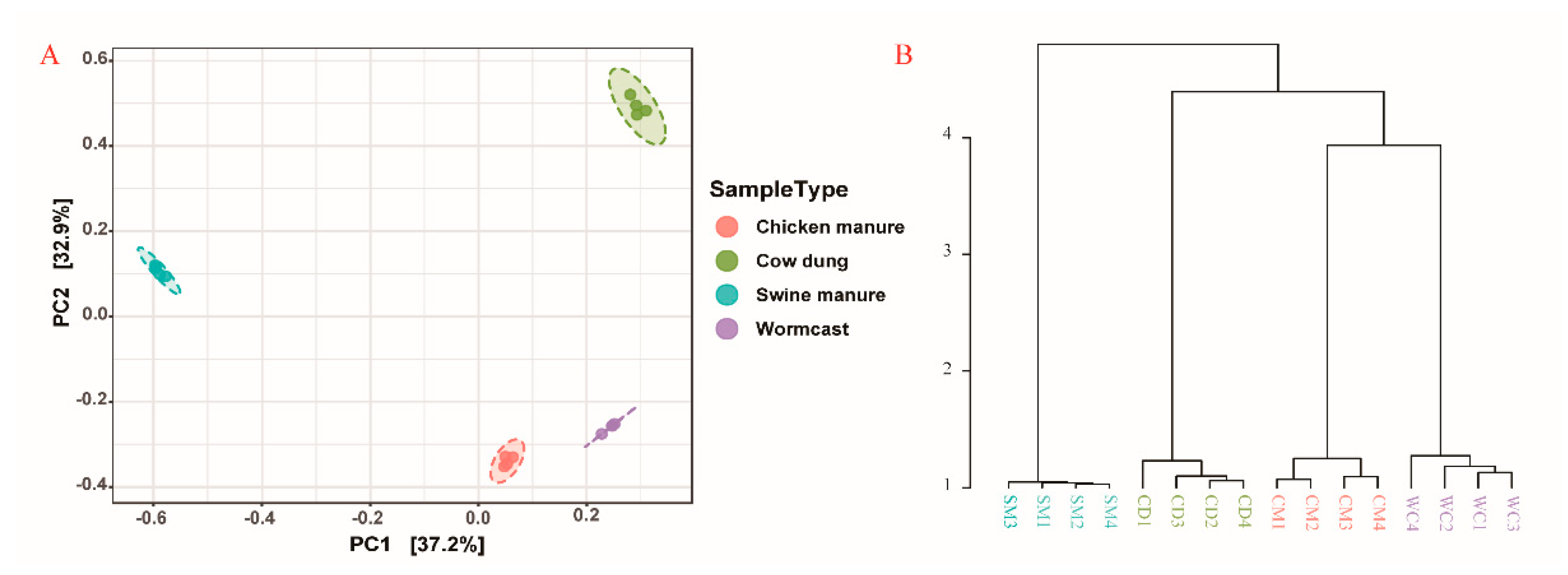
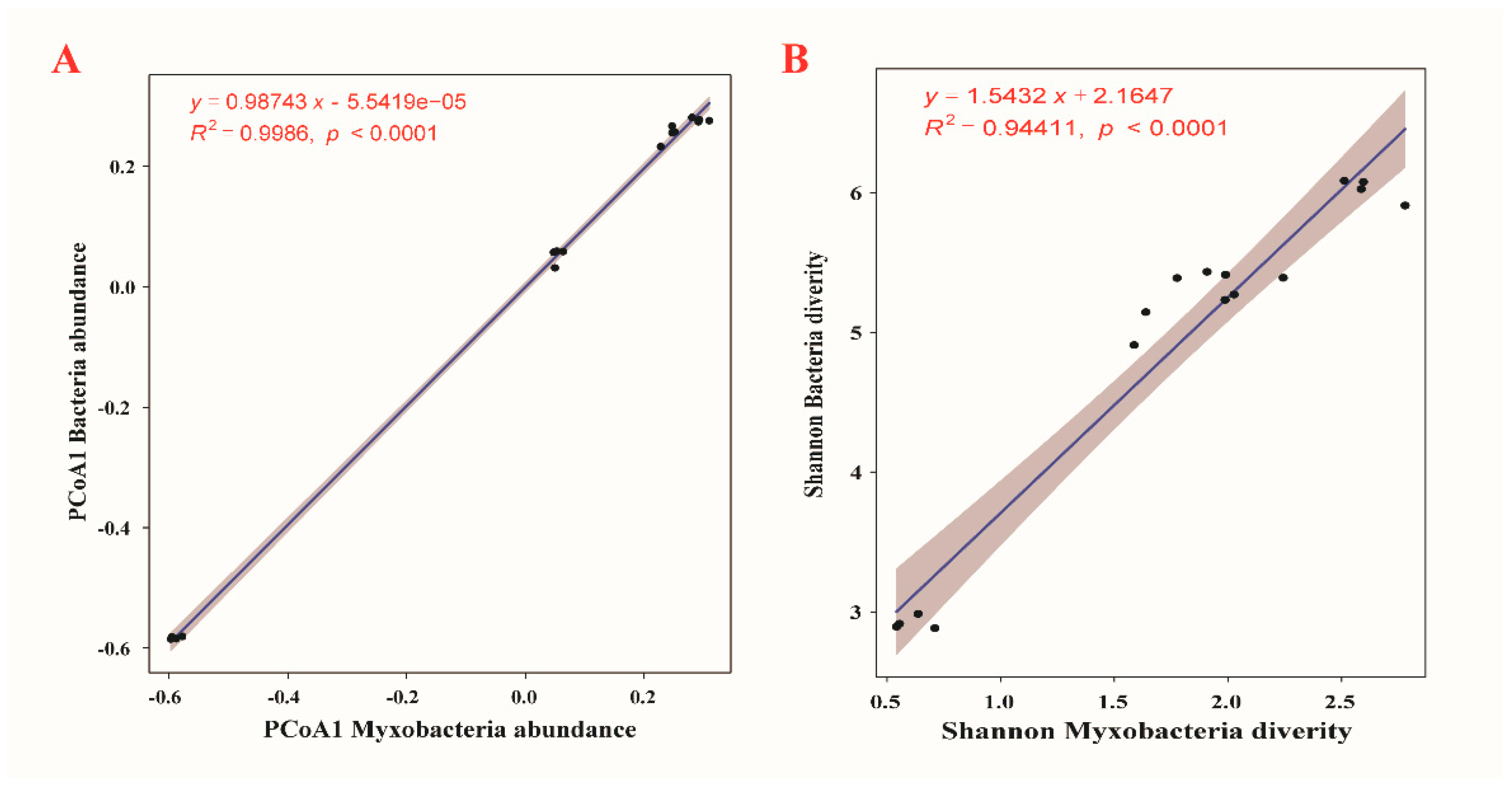
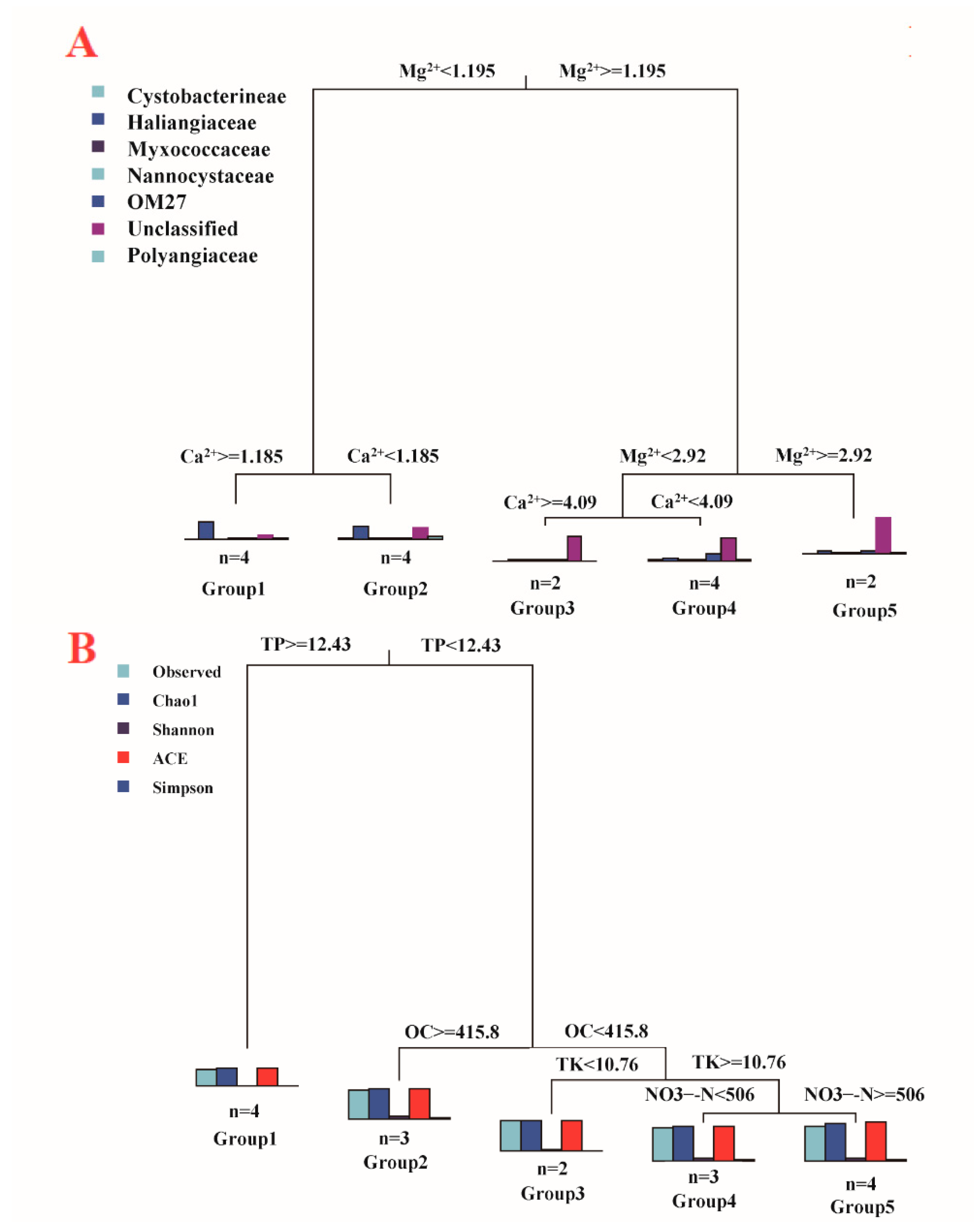
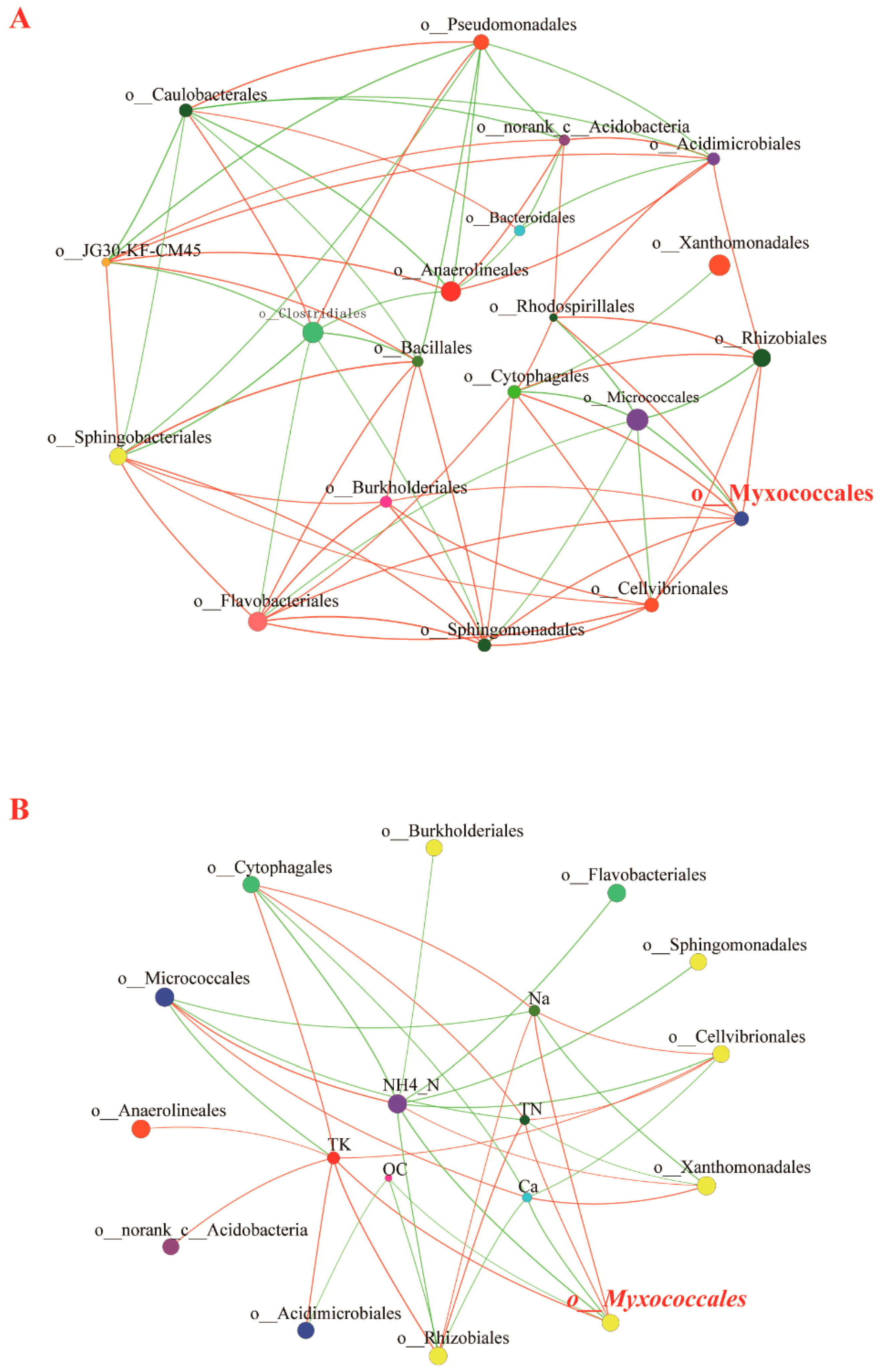
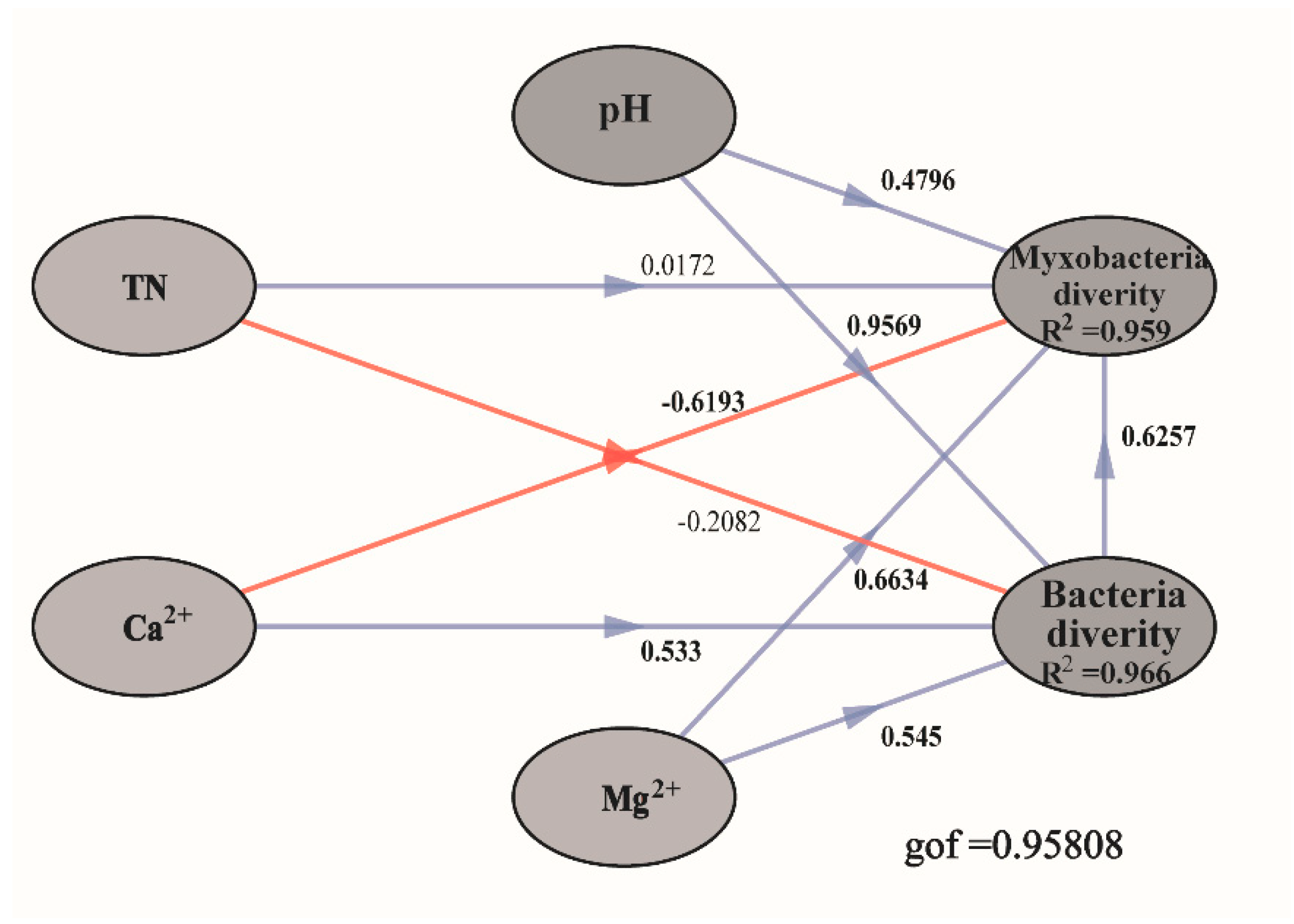
| Physicochemical Property | Chicken Manure | Swine Manure | Cow Manure | Wormcast |
|---|---|---|---|---|
| pH | 7.165 ± 0.061 | 7.505 ± 0.153 | 9.305 ± 0.116 | 7.77 ± 0.081 |
| OC g·kg−1 | 196.485 ± 0.427 | 281.715 ± 0.244 | 416.285 ± 0.728 | 127.27 ± 0.129 |
| TN g·kg−1 | 21.348 ± 0.134 | 24.108 ± 0.90 | 21.693 ± 0.102 | 13.293 ± 0.22 |
| TP g·kg−1 | 9.7475 ± 0.195 | 15.013 ± 0.013 | 4.3425 ± 0.033 | 9.305 ± 0.013 |
| TK g·kg−1 | 10.75 ± 0.084 | 11,233 ± 0.78 | 12.295 ± 0.465 | 17.51 ± 0.259 |
| NO3−-N g·kg−1 | 1078.05 ± 5.98 | 6.105 ± 0.183 | 4.78 ± 0.143 | 506.115 ± 1.96 |
| NH4+-N g·kg−1 | 282.23 ± 4.224 | 8175.23 ± 8.517 | 92.818 ± 0.637 | 143.305 ± 2.04 |
| Ca2+ g·kg−1 | 6.21 ± 0.075 | 2.07 ± 0.097 | 0.4125 ± 0.033 | 1.9825 ± 0.108 |
| Mg2+ g·kg−1 | 2.92 ± 0.034 | 1.5175 ± 0.041 | 0.995 ± 0.037 | 2.3525 ± 0.073 |
| Na+ g·kg−1 | 2.0275 ± 0.122 | 2.61 ± 0.265 | 12.688 ± 0.143 | 3.83 ± 0.081 |
Publisher’s Note: MDPI stays neutral with regard to jurisdictional claims in published maps and institutional affiliations. |
© 2021 by the authors. Licensee MDPI, Basel, Switzerland. This article is an open access article distributed under the terms and conditions of the Creative Commons Attribution (CC BY) license (https://creativecommons.org/licenses/by/4.0/).
Share and Cite
Dai, W.; Wang, N.; Wang, W.; Ye, X.; Cui, Z.; Wang, J.; Yao, D.; Dong, Y.; Wang, H. Community Profile and Drivers of Predatory Myxobacteria under Different Compost Manures. Microorganisms 2021, 9, 2193. https://doi.org/10.3390/microorganisms9112193
Dai W, Wang N, Wang W, Ye X, Cui Z, Wang J, Yao D, Dong Y, Wang H. Community Profile and Drivers of Predatory Myxobacteria under Different Compost Manures. Microorganisms. 2021; 9(11):2193. https://doi.org/10.3390/microorganisms9112193
Chicago/Turabian StyleDai, Wei, Ning Wang, Wenhui Wang, Xianfeng Ye, Zhongli Cui, Jieling Wang, Dandan Yao, Yuanhua Dong, and Hui Wang. 2021. "Community Profile and Drivers of Predatory Myxobacteria under Different Compost Manures" Microorganisms 9, no. 11: 2193. https://doi.org/10.3390/microorganisms9112193
APA StyleDai, W., Wang, N., Wang, W., Ye, X., Cui, Z., Wang, J., Yao, D., Dong, Y., & Wang, H. (2021). Community Profile and Drivers of Predatory Myxobacteria under Different Compost Manures. Microorganisms, 9(11), 2193. https://doi.org/10.3390/microorganisms9112193





